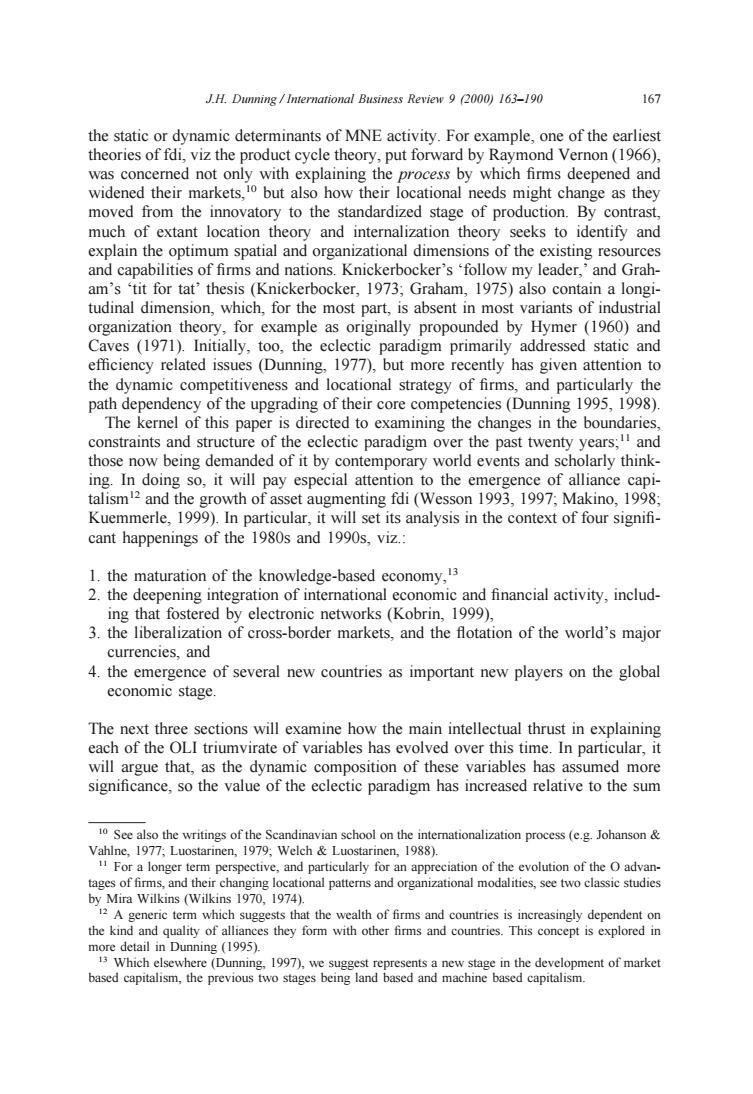正在加载图片...

JH.Dunning/International Business Review 9200)163-190 6 the static or dynamicdete inants of MNE activity.For mple,one of the eories of fd ct cycle theory rd by ernon was cor not onl by wh h hr eepened an rkets how t ationa ds cha moved from the innovatory to the standardized stage of production.By contra much of extant location theory and internalization theory seeks to identify and explain the optimum spatial and organizational dimensions of the existing resources and capabilities of firms and nations.Knickerbocker's 'follow my leader,'and Grah- am's 'tit for tat'thesis(Knickerbocker,1973;Graham,1975)also contain a longi tudinal dimension,which,for the most part,is absent in most variants of industrial organization theory,for example as originally propounded by Hymer(1960)and Caves (1971).Initially,too,the eclectic paradigm primarily addressed static and efficiency related issues (Dunning.1977),but more recently has given attention to the dynamic competitiveness and locational strategy of firms,and particularly the path dependency of the upgrading of their core cor petencies(Dunning 1995.1998) The kernel of this r is directed to examining the changes in the boundaries constraints and structi of the eclectic paradigm over the and hos ng de anded of it by y world e nts and scholarly think- In do ial att to the of alli em ng (We 9931997:Mak 1999 199 a analysis in the e conte ur sign cant happenings of the 1980s and 1990s,viz. 1.the maturation of the knowledge-based economy, 3 2.the deepening integration of interational economic and financial activity,includ- ing that fostered by electronic networks (Kobrin,1999), 3.the liberalization of cross-border markets,and the flotation of the world's major currencies.and 4.the emergence of several new countries as important new players on the global economic stage The next three sections will examine how the main intellectual thrust in explaining each of the OLI triumvirate of variables has evolved over this time.In particular.it will argue that,as the dynamie of these variables significance.so the value of the eclec paradigm has increased relative to the s 10 See ale mationalization process (eg.Johanson For a longer term perspective,and particularly for an appreciation of the evolution of the O advan onal patterns and organ 7 A generic term which suggests that the wealth of firms and countries is increasingly dependent on the kind es they form with other firms and countries.This concept is explored in g1007e e in the develor ment of market based capitalism the previous two stages being land based and machine based capitalism J.H. Dunning / International Business Review 9 (2000) 163–190 167 the static or dynamic determinants of MNE activity. For example, one of the earliest theories of fdi, viz the product cycle theory, put forward by Raymond Vernon (1966), was concerned not only with explaining the process by which firms deepened and widened their markets,10 but also how their locational needs might change as they moved from the innovatory to the standardized stage of production. By contrast, much of extant location theory and internalization theory seeks to identify and explain the optimum spatial and organizational dimensions of the existing resources and capabilities of firms and nations. Knickerbocker’s ‘follow my leader,’ and Graham’s ‘tit for tat’ thesis (Knickerbocker, 1973; Graham, 1975) also contain a longitudinal dimension, which, for the most part, is absent in most variants of industrial organization theory, for example as originally propounded by Hymer (1960) and Caves (1971). Initially, too, the eclectic paradigm primarily addressed static and efficiency related issues (Dunning, 1977), but more recently has given attention to the dynamic competitiveness and locational strategy of firms, and particularly the path dependency of the upgrading of their core competencies (Dunning 1995, 1998). The kernel of this paper is directed to examining the changes in the boundaries, constraints and structure of the eclectic paradigm over the past twenty years;11 and those now being demanded of it by contemporary world events and scholarly thinking. In doing so, it will pay especial attention to the emergence of alliance capitalism12 and the growth of asset augmenting fdi (Wesson 1993, 1997; Makino, 1998; Kuemmerle, 1999). In particular, it will set its analysis in the context of four signifi- cant happenings of the 1980s and 1990s, viz.: 1. the maturation of the knowledge-based economy,13 2. the deepening integration of international economic and financial activity, including that fostered by electronic networks (Kobrin, 1999), 3. the liberalization of cross-border markets, and the flotation of the world’s major currencies, and 4. the emergence of several new countries as important new players on the global economic stage. The next three sections will examine how the main intellectual thrust in explaining each of the OLI triumvirate of variables has evolved over this time. In particular, it will argue that, as the dynamic composition of these variables has assumed more significance, so the value of the eclectic paradigm has increased relative to the sum 10 See also the writings of the Scandinavian school on the internationalization process (e.g. Johanson & Vahlne, 1977; Luostarinen, 1979; Welch & Luostarinen, 1988). 11 For a longer term perspective, and particularly for an appreciation of the evolution of the O advantages of firms, and their changing locational patterns and organizational modalities, see two classic studies by Mira Wilkins (Wilkins 1970, 1974). 12 A generic term which suggests that the wealth of firms and countries is increasingly dependent on the kind and quality of alliances they form with other firms and countries. This concept is explored in more detail in Dunning (1995). 13 Which elsewhere (Dunning, 1997), we suggest represents a new stage in the development of market based capitalism, the previous two stages being land based and machine based capitalism